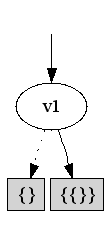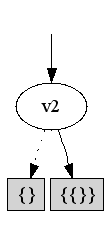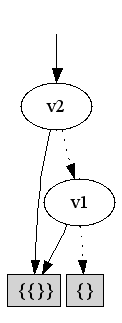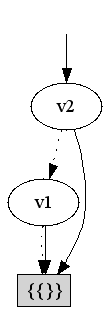| a | b | c | d | e | f | g |
 |
 |
 |
 |
 |
 |
 |
The basic Z-BDD class is ZDD. It uses BDD-style initialization
ZDD zdd = new ZDD(1000,100); |
It contains all the basic operations, which are:
This sequence of code builds all the examples found in Minato original paper:
ZDD zdd = new ZDD(1000,100); int v1 = zdd.createVar(); int v2 = zdd.createVar(); int a = zdd.empty(); int b = zdd.base(); int c = zdd.change(b, v1); int d = zdd.change(b, v2); int e = zdd.union(c,d); int f = zdd.union(b,e); int g = zdd.diff(f,c); |
Note that in contrast to BDDs, Z-BDD variables (here v1 and v2) are just number and no Z-BDD trees. You can't do stuff like int a = zdd.union(v1,v2)!!!
As with BDDs, you can visualize Z-BDD trees by single calls in JDD:
zdd.print(g); zdd.printSet(g); zdd.printCubes(g); |
7. v2: 1, 1
{ base, v2 }
{ 00, 10 }
But you will probably prefer the DOT printer printDot(). It was used to produce the following images:
| a | b | c | d | e | f | g |
 |
 |
 |
 |
 |
 |
 |
The ZDD class has some sub-classes with additional operators. These operators are used in more advanced applications. In some cases, the new operators outperform the basic Z-BDD operators, see for example the N Queens applet where a Z-BDD/CSP algorithms is included.
ZDD2 contains additional operations for unate cube set algebra. These operations are shown below
| Class jdd.zdd.ZDD2 | ||
| return type | method | parameters |
| void | showStats | |
| void | internal_test | |
| int | mul | ( int, int ) |
| int | div | ( int, int ) |
| int | mod | ( int, int ) |
ZDDCSP adds extra ZDD operations for CSP problems. it is based on 'On the properties of combination set operations', by Okuno, Minato and Isozaki.
The new operations are:
| Class jdd.zdd.ZDDCSP | ||
| return type | method | parameters |
| int | restrict | ( int, int ) |
| void | showStats | |
| void | internal_test | |
| int | exclude_slow | ( int, int ) |
| int | exclude | ( int, int ) |
ZDDGraph is intended to [in near future] include common ZDD operations used in graph algorithms, as explained in Coudert's paper.
The graph-operations we are working on are:
| Class jdd.zdd.ZDDGraph | ||
| return type | method | parameters |
| void | internal_test | |
| int | allEdge | ( int, int ) |
| int | allEdge | |
| int | noSubset | ( int, int ) |
| int | noSupset | ( int, int ) |
| int | maxSet | ( int ) |
| int | MaxDot | ( int, int ) |
There are several additional Z-BDD objects that are currently not documented in the API.